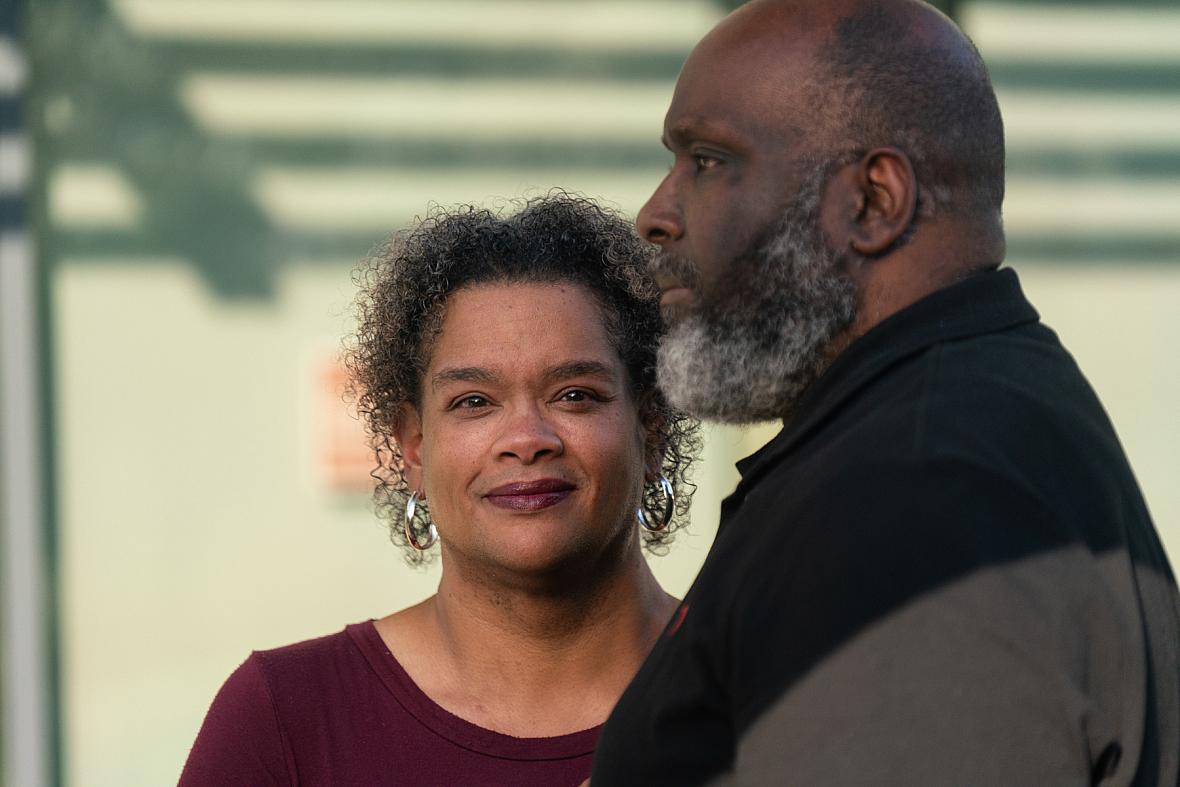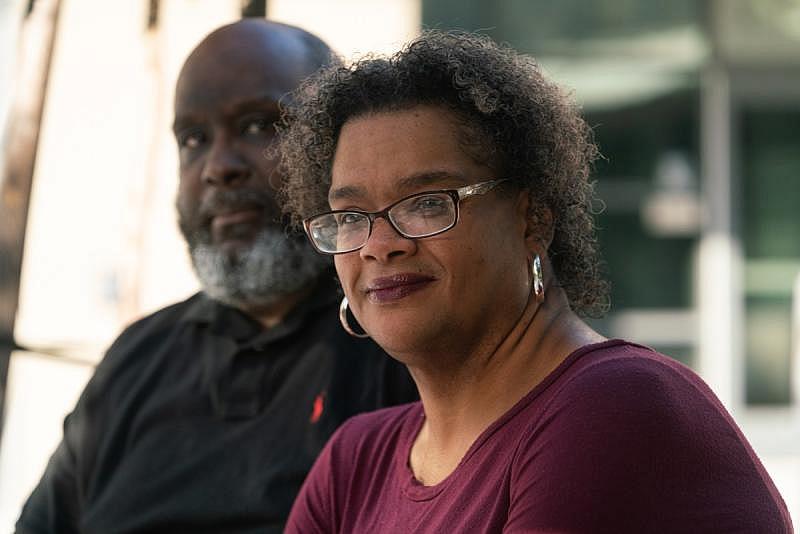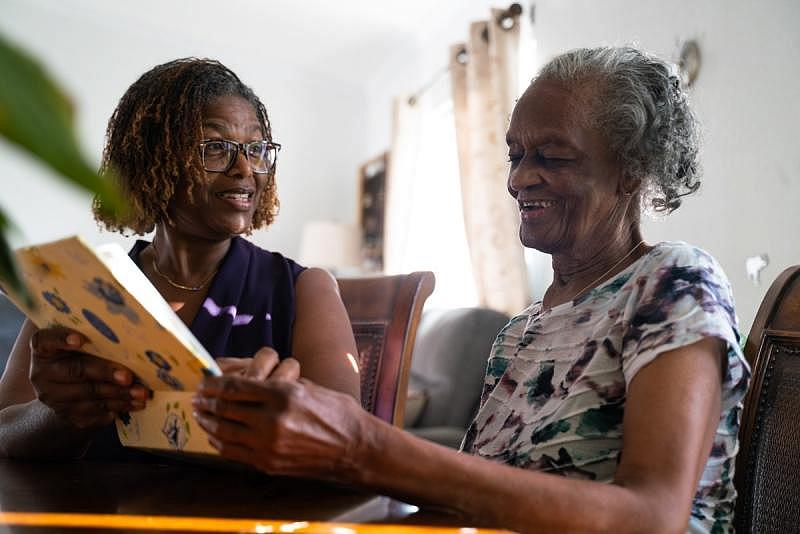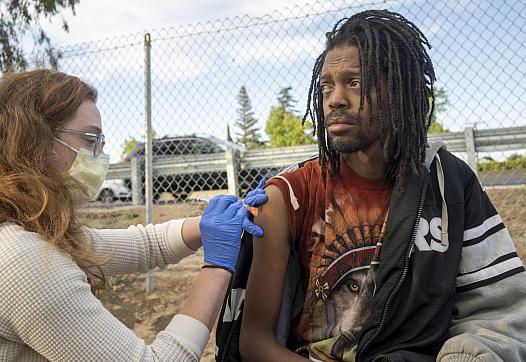Real Talk: Three Sacramento Families Discuss Their COVID Stories — And Share How The Vaccine Is Protecting Them
The story was originally published in The Observer with support from the USC Annenberg Center for Health Journalism's 2021 California Fellowship.

Milton Woodberry says protecting Angelina, his wife of 19 years, from COVID-19 was a no brainer. The couple and their two teens got the vaccine and are enjoying a sense of normalcy.
Credit: Louis Bryant III / OBSERVER
As some still debate whether or not the coronavirus is real or if the vaccine was cooked up by the government to control the masses, local families are weighing fact against fiction as they see it and deciding what is best for them.
Health officials say a recent surge in COVID-19 cases is certainly real enough. California lowered many of its restrictions on June 15 and numbers have steadily increased since. Dr. Olivia Kasirye, Sacramento’s County Public Health Officer, said on August 5 that she was seeing 300-400 new cases reported every day.
The low vaccination rate among the Black population has long been cause for concern and in the 30 days following the County reopening, the number of local African Americans who tested positive for COVID-19 doubled from 11% to 22%.
“We really need to get the vaccine out and get people vaccinated because that’s what will bring the numbers down,” Dr. Kasirye said.

With Angelina Woodberry in dialysis for eight hours, three days a week, her family doesn’t want her to spend time worried about COVID-19. Credit: Louis Bryant III / OBSERVER
Officials point to historic hesitancy in the Black community dating back to when White doctors used Black bodies to test racist pain tolerance theories and to the infamous Tuskegee Study where Black men from 1930s-1970s thought they were getting care for syphilis, but were left untreated in favor of being studied by researchers.
“I think education is key in addressing the myths and misinformation that is circulating in the community that people buy into and believe,” said California Black Health Network President Rhonda Smith. “Also, understanding what the barriers are to getting vaccinated. Is it truly vaccine hesitancy or is it access?”
“I think it’s important for people to really understand that the real choice is between life and death,” Ms. Smith continued. “Yes, there may be some side effects with the vaccine but the benefits outweigh the risks.”
According to Sacramento County, as of August 5 there were 1,441 “breakthrough” cases — people who got COVID-19 despite being fully vaccinated — and two people who were fully vaccinated have died. While families have concerns, some say they’re enjoying a level of comfort knowing they’ve protected themselves and their families.
THE WOODBERRYS
The list of people who Milton Woodberry, Sr. knows who have gotten sick from COVID-19 reads like a laundry list. Woodberry, 51, quickly rattles off friends, family members and acquaintances across America:
“My oldest niece who lives in Georgia, one of my best friends and his family, several cousins, church friends, and co-workers. An uncle who lived in Detroit, that I hadn’t seen since I was a kid, died from it.”
Woodberry, a Concierge Customer Service worker with Blue Shield of California, told himself that when the vaccine became available, he’d get it and he did.
His job suggested employees be vaccinated, but his main motivation was protecting his wife of 19 years. The family has a litany of chronic health issues that historically plague African Americans including Type 2 Diabetes and hypertension. Woodberry also has psoriasis, an autoimmune disorder and the medications he takes for it and his high blood pressure compromise his immune system. His wife Angelina, 47, is on dialysis and needs a kidney transplant.
In addition to contributing to her renal failure, diabetes caused a stroke in Mrs. Woodberry’s right eye, robbing her of its use. It also caused neuropathy in her feet, which led to charcot foot, a breaking down of the bones. She has also had several surgeries planned that were cancelled due to COVID.
Despite her many ailments, Mrs. Woodberry, who works in behavioral health as the Consumer Advocate Liaison for Sacramento County, considers herself to be in “fair” health with her conditions “under control and managed.”
Dialysis, however, weakens her immune system, making her more at-risk of getting COVID-19 and suffering heavily. Her physicians expressed concern at the beginning of the pandemic. Staying at home may have been what the doctor ordered, but total adherence wasn’t an option, as Mrs. Woodberry must go to a local dialysis center three days a week, from 9:00 p.m. to 4:00 a.m..
The Woodberrys sat down together as a family and discussed COVID’s seriousness and what would happen if any of them got it.
“We were all at high risk of complications if we contracted the virus,” Angelina Woodberry said. “I have been on dialysis for seven years and they know how fragile my health is.”
She got the Moderna shot at her dialysis center and was fully vaccinated by March 9. Milton Sr. tried to get a vaccine appointment at Kaiser around the same time, but was repeatedly told that he “wasn’t in the right tier yet.”
California’s tier system opened up vaccination eligibility in stages, with seniors first, then first responders and other essential workers. As Gov. Gavin Newsom promised equity in the vaccine rollout, community advocates argued that Blacks, predisposed to chronic illnesses and disproportionately represented in the COVID ranks, should have been placed higher on the priority list.
“When he told them about me, they changed their tune and he got the shot almost immediately,” Mrs. Woodberry said of their personal quest for vaccination.
Her husband got the Pfizer shot at the mass drive-thru site at Cal Expo as did both children, a month later.
“I believe vaccines are vital to the health and wellbeing of society,” Mrs. Woodberry said. “I remember having chicken pox in elementary school before the vaccine. I still have scars from it. My children will never have to go through that. They received all of their vaccines.”
The oldest, 19-year-old daughter Averi, is afraid of needles, her mom says, and was initially hesitant to get the shot.
“After explaining to her how it would help keep me safe, she did it. As for my son, COVID took away his school year and football season. He wanted the shot to get it over with so he could resume normal life.”
Being vaccinated holds great benefits for the Woodberry family, giving them the “peace of mind” that they have a “level of protection.” The number of vaccinated people getting COVID of late doesn’t worry Milton Woodberry all that much.
“I know well enough that although COVID can be contracted, the vaccine should fight it off easier,” he said.

Sharon Saffold, left, is close with her mother, Julia, 89, who lives with dementia. She and her three sisters share in her care and are working to keep the local senior safe during the continued pandemic. Credit: Louis Bryant III / OBSERVER
Vaccination, and a renewed sense of normalcy, has allowed them to do a bit of travelling, with the couple going to Las Vegas twice in the last four months and to the Bay Area a couple of times with their children.
“Our daily life goes on,” Milton Woodberry said.
His wife agrees. She stays masked up and follows her instincts.
“My gut and 47 years of experience with humans tells me to protect myself. That said, we go on vacation and to the movies. We mask in public and sanitize. I’m not licking door knobs, but I’m not cowering in fear either,” she said.
Mrs. Woodberry is grateful that her family made her health their top priority, but recent talk of spikes and variants doesn’t sway her from living her life.
“COVID has never really concerned me,” said the woman who gets annual flu shots.
“I was hit with a terminal diagnosis seven years ago. After you know you’re going to die, nothing really concerns you.”
THE SAFFOLDS
Julia Saffold has logged a lot of miles in the last year and a half. Going every other week from Sacramento to Stockton, on to Union City and back again.
The 89-year-old former cannery worker didn’t have the option of staying still during the coronavirus pandemic. Living with dementia and cared for by four adult daughters, travel has been essential. She rotates between the sisters — Jeanette Hale, Sharon Saffold, Karen Blount and Valencia Saffold — switching homes and cities Sunday to Sunday.
Since the beginning, COVID-19 has been a hot topic for the family. They knew they’d get the vaccine when it became available to them, but had to discuss the “when.”
“We didn’t want to be the first ones in line,” shared Valencia Saffold, the youngest of Julia’s daughters and the first to take on her full-time care.
“We wanted to know that there were no issues with it,” she explained. “We wanted it to have been given out quite a bit before any of us got it.”
Julia was diagnosed with dementia in her late 70s. Valencia was single and didn’t have any children, so Julia went to live with her for four years. When Karen later retired, the two would care for her two weeks at a time between their households. Then a health issue impacted their mother’s sleep patterns and it became difficult and exhausting for one person to care for her for that long a period.
Prior to the floating care system, Julia Saffold lived independently. Her husband Amos died in 1989. She volunteered as a foster grandparent, mentored incarcerated youth and worked with adults with disabilities.
As she once assisted those who needed a little help, her family now does for her.
“We try to be as diligent as possible with maintaining the hand cleaning and that sort of thing, because we just didn’t want to have to deal with what it would mean if we brought COVID into our homes, and how it could impact our mother since she’s advanced in age, and so it was really important for us to make sure we did everything possible,” shared Sharon Saffold, who lives in South Sacramento. Sharon is the former program manager for Sacramento County Department of Health and Human Services’ Black Infant Health Program.
With pre-existing health conditions and outbreaks among care providers, seniors were hit exceptionally hard by COVID in early 2020. In Sacramento County, the highest number of COVID deaths are still among people between the ages of 70 to 80. Nearly 39% of the people who have died in the county were living in care facilities.
The Saffolds are thankful they haven’t had to send their mom to a convalescent hospital before or during the pandemic.
“We read about all the things that were going on there,” Valencia Saffold said. “Plus the fact that people couldn’t go and visit their loved ones.”
They followed all the recommended safety precautions, sanitizing their home environments, wearing face masks, washing their hands after having been outside, limiting Julia’s time spent in the public and her nine grandchildren and 18 great grandchildren and holding traditional holiday gatherings in smaller groups and on Zoom.
As safe as they all were, Sharon Saffold’s adult daughter came down with COVID-19. While she wasn’t working at the time, the daughter is a nurse who is accustomed to caring for the eldery. She’s naturally cautious and still got sick.
“She really took a lot of precautions, so we were really shocked when she said she had it,” said Ms. Saffold. She describes her daughter’s bout with the virus as non-severe.
“She just lost smell and taste. The minute she knew she had something, she let us all know,” she recalls. “We kept ourselves and my mom away from her.”
Even though they hadn’t been around each other, Sharon and Julia got tested out of an abundance of caution. Sharon has taken three COVID-19 tests, all negative and will continue to test, if need be. They’ve all been vaccinated as well, getting either the Pfizer or the Moderna shots, at different times.
There were other COVID-19 positives in their circle.
“Even though I’ve got my shot, my daughter’s stepdaughter started going to school, and then she actually contracted it, so her household is now under quarantine,” Sharon Saffold said.
It’s why they’re so diligent.
“The first time we had her put a mask on, when the pandemic first started, she never really asked why or had any issues with it,” Valencia Saffold said. “I asked her, ‘Do you know why you’re wearing a mask?’ and she said ‘yes, so I won’t get sick.’”
Helping their mother remain in good health and maintain a decent quality of life is in the family’s “DNA,” says Valencia Saffold.
They grew up seeing Julia and Amos taking care of their parents, including their paternal grandfather who was brought from Oklahoma to Stockton to live with them and lived to be 96.
“It’s kind of like a legacy of seeing our family members take care of our elders,” Valencia shared. “It’s just kind of a natural process for us to do it because we saw examples of it as we were growing up.”
Dementia in isolation can be an even lonelier place, so Julia Saffold’s daughters try to keep her engaged. She likes coloring books and crossword puzzles and looking at old family photos helps jog fading memories.
It can all be frustrating and if she gets in “one of her moods,” one of the other sisters will call the others and they’ll soon have her smiling and laughing.

After getting sick with COVID-19, Maria Herndon says Jesus gave her an ultimatum and she chose life — and the vaccine. Credit: Louis Bryant III / OBSERVER
“That’s the blessing of it, too, is that we all work together and support each other and help out where we can. We’re getting older too, so sometimes one of us may have other commitments, our own health issues we’re taking care of, and one of the others will just step up to take over,” Sharon Safffold said.
If one of the sisters got COVID, even now, despite having been fully vaccinated, it would throw a wrench in the system. Early on in the pandemic, Sharon’s interaction with her own grandchildren kept her out of the care rotation. She also took a break when her son died.
The others stepped in and took on more responsibility until she was in a better place to return and help again.
Protecting mom is non-negotiable, the Saffolds say.
“I know I would not be where I am, if it wasn’t for my mother and father,” Valencia Saffold declared. “What they sacrificed and the love that they poured into me and my siblings and the foundation that they set for us. The one main thing I can always remember my father telling us was, ‘always take care of your mom’.”
THE HERNDON HOUSEHOLD
Retired math teacher Maria Herndon hadn’t really been on the fence about whether or not to get the vaccine, but deduces now that it was a real “come to Jesus moment” that actually convinced her to do it.
Herndon, 74, got the vaccine this spring, after recovering from a debilitating bout with COVID-19. She likely got it from one of her grandchildren who come to her house in South Sacramento quite frequently. Prior to developing symptoms, she’d been unaware that their mother had already been sick. She learned of it after the fact. She was dizzy and coughing one day and a grandchild said, “Mama has that too.”
“I’m 74, so I know what they mean when they say older people kind of have to protect themselves,” Ms. Herndon said.
While sick and in bed for seven days, the proud member of St. Paul Missionary Baptist Church says she had a vision of Jesus, who gave her an ultimatum.
“The way I remember it, I was laying in the bed and Jesus was sitting next to me in an armchair-like thing,” she recalls.
A friend later asked her “what color” Jesus was. The million-dollar question. One to which Ms. Herndon just doesn’t have any sense of an answer.
“Everything was glowing. The chair, his face, his body, except he had kind of dark hair, that’s all I remember,” she says. “He turned to me and he said, ‘Do you want to come with me? Or do you want to go back to your family?’”
Thinking of her four grandchildren, she says it didn’t take long for her to answer.
She doesn’t know whether to call what she experienced a vision or a fever-fueled dream. Ultimately labels don’t matter, she says.
“I know I woke up well,” she said.
So thankful to have been “delivered” from her illness, Ms. Herndon rushed down to South Sacramento Kaiser the very next day, ready to sign up for the vaccine. She was told to pump her brakes, that she’d need to wait two weeks, as she’d just recovered. She went back and got the Moderna shot.
“I haven’t had any more problems, but I’m stressed out, because it seems so easy (to get sick). I’ve got four grandkids, three who are under 13 and they say they can carry it.”
Concern is high for Ms. Herndon. Many, she says, are misinformed about the vaccine and others have politicized it.
“I don’t understand this kind of madness. People my age, we had polio, we had smallpox and vaccination is a precaution. Somehow this thing got tied to Trump and we’re nuts; he’s not a savior, if you get sick here, you’re out of here. These are just crazy times.”
Adding to her state of unease is her adult son’s refusal to get vaccinated.
“He scares me, he won’t get it. He won’t get the vaccination because he’s afraid. He understands that they’re putting the virus in your body, but he’s not understanding that that’s how you build immunities.”
The two live together in the same house.
“When he comes home from work, he goes and takes a shower, and he stays in his room and I stay on the other side of the house,” Ms. Herndon shared.
“He’s very hard headed. I don’t understand this new generation. Maybe it’s because they’ve not had this before and so they don’t understand what a vaccine does.”
The Delta variant also has her worried.
“I’m not a scientist, but I love science and understand mutations. The disease is trying to survive. It’s like a human being, whatever you send it, it’s going to try to fight it off, so it can stay around,” she said.
Even though she doesn’t remember much of actually being ill from COVID-19, Ms. Herndon is glad to still be around.
“I’m just grateful to be here. We’re dying way more than other people,” she said of African Americans.
The Centers For Disease Control and Prevention (CDC) lists Blacks as the third highest racial group for COVID-19 deaths at 13.8 percent, only behind Whites at 58.7 and Hispanics at 18.6 percent.
With the numbers of cases on the rise again, Ms. Herndon has noticed how folks are on high alert. Her 6-year-old grandson was recently sent home from school, where he was doing in-person instruction two days a week.
“He had a very runny nose. I thought he had a cold, but because they’d missed so much school, I took him up there and they wouldn’t even let him walk on the campus. They said, ‘Oh no, he’s sick.’ The school seemed to be really concerned about it, but I didn’t get anything from him either.”
The Herndons keep masks in their cars. Ms. Herndon says there’s a pile of them on a table inside the house as well.
“I know that the variant is out there, but I’m pretty much in the house. I feel safe. Maybe I shouldn’t.”


